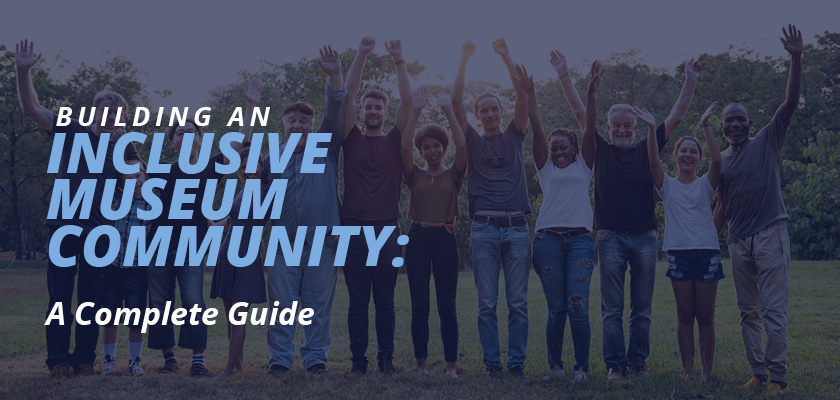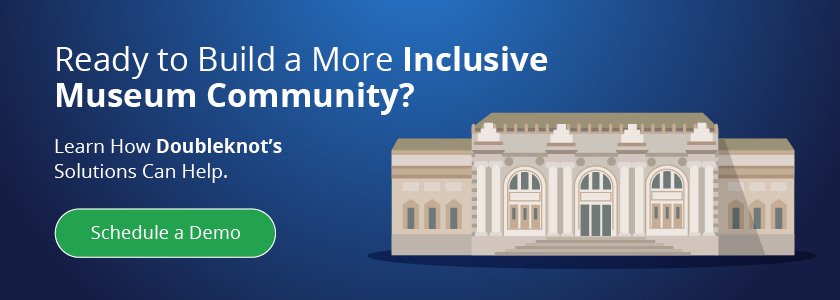Building an Inclusive Museum Community: A Complete Guide

For as long as museums have existed, they’ve been essential to their communities. They do more than just provide visitors with access to knowledge—they reflect culture in a way that, when done well, can create a sense of belonging.
As museums have evolved over time and been influenced by the digital age, their reflection of culture has also changed. The amount of information available on the internet means that there’s now even more of a need for museums to work on actively engaging their communities. For visitors, the experience of going to a museum is what sets it apart from just researching art, history, science, or other topics online.
More than that, museums need to prioritize inclusion. Engaging the community well means engaging the entire community, so that people of all ages, backgrounds, and abilities can make the most of their visit.
In this guide, we’ll cover all you need to know to get started with inclusive museum community engagement, including:
- Why Are Museums Important to the Community?
- What Is Inclusive Museum Community Engagement?
- 6 Strategies for Building an Inclusive Museum Community
- Additional Resources for Museum Community Engagement
Community engagement and inclusion are just two parts of effective museum management. With the right strategies and tools, you’ll be well on your way to helping all of your museum visitors have a standout experience. Let’s dive in!
 Why Are Museums Important to the Community?
Why Are Museums Important to the Community?
As long as museums have existed, they’ve preserved the history and culture of their surrounding locations. But over time, they’ve taken on even larger roles within communities.
Some important functions of museums within surrounding communities include:
- Providing access to cultural education. There’s a reason why museums are popular destinations for school groups and tourists. Museums provide a cultural snapshot of that specific area, helping all visitors to learn about that location while enjoying a new experience.
- Creating a sense of belonging for people of all ages and backgrounds. Most museums have a target audience of “the general public,” allowing everyone not only to visit but also to connect with the exhibits and the other visitors. Membership programs can also create an even stronger community within a museum.
- Adapting to changing circumstances. In 2020 and 2021, many museums found new ways to reach their communities during the global pandemic, like virtual events and online tours. Also, museums often respond to societal trends through special exhibits or initiatives.
- Reflecting the surrounding community in the past, present, and future. Although art and history museums in particular preserve the way their community used to be, they can also provide insight into what a community is like now and where it’s going. Plus, they invite visitors to reflect with them on the past, present, and future.
To fill all these functions, museums need to emphasize both community engagement and inclusion. An inclusive museum allows everyone in the community to engage, and an engaged community helps a museum to thrive.

What Is Inclusive Museum Community Engagement?
Essentially, inclusive museum community engagement is about bringing as many people as possible together to provide them with educational experiences relevant to the museum’s focus.
Engagement in this way starts with the content your museum creates as it works to relate to your community’s interests and current events or concerns. But it doesn’t stop there! Making a museum relevant to its community also extends to marketing, events, and other interactive experiences that allow community members to connect with the content in a real way—not just learning it, but living it.
For example, let’s say an art museum designs an exhibit about a painter who was born nearby. Although the artist’s birthplace is a first step toward demonstrating relevance, the museum could plan a special opening event, host a painting workshop that goes along with the exhibit’s theme, and post about all these activities on social media to engage the community even more.
The most important aspect of community engagement, though, is inclusion. Museums need to ensure they don’t gatekeep any of these experiences but instead extend them to every community member, no matter their age, gender, race, ethnicity, ability, socioeconomic status, or any other aspect of their identity.

6 Strategies for Building an Inclusive Museum Community
Community engagement and inclusion initiatives only benefit museums and their visitors when they’re actionable. Putting these theories into practice will take some planning, creativity, and flexibility. You can start building an inclusive museum community with these six helpful strategies:
1. Design opportunities for specific age groups.
While many museums try to appeal to the general public, you’ll be able to do so more effectively if you have something available for every age group. Some ideas to target specific age groups include:
- Creating an area specifically for children. Young children can easily become restless as their family walks around a museum. Both the kids and their families will appreciate it if you have an area for children to make a craft or play as they learn.
- Establishing a senior tour. A weekday morning would be a great time to try to bring seniors to a museum. Offer a discounted admission rate at that time for ages 65 and up, and consider running a guided tour at a leisurely pace.
- Hosting an evening event for young adults. Consider holding an “after hours” gathering on a Friday night so that people in their 20’s and 30’s can unwind with a fun museum experience after a long week.
When people in every age range in your community know that there’s a museum experience designed specifically for them, they’ll not only have a good time but also feel accepted. If they feel like they belong at a museum, they will not only come back but also tell their friends and family about their experience.
2. Spread the word in a variety of ways.
Marketing is just as important for museums as it is for businesses. Even though your main goal isn’t selling a product in the traditional sense, you’re “selling” an experience to visitors. This means that you need to spread the word about upcoming events, new exhibits, and other museum happenings.
Since each segment of your community has different communication preferences, you’ll want to use several marketing channels, such as:
- The museum’s website
- Email newsletters
- Direct mail
- Print or digital flyers
- Social media
Getting the word out about museum happenings early, often, and in many ways will help you engage community members by not only increasing the chances of their visiting your museum but also communicating with them in a way they’ll be receptive to.
3. Collect and apply visitor feedback.
Once you’ve started bringing the community together at your museum, you’ll be able to engage them further by asking them for feedback on their experiences. Feedback collection and marketing strategies often inform each other. You can adjust your marketing strategy based on visitor feedback, and you can send feedback forms through several different communication channels.
More than that, collecting visitor feedback can help you plan museum events and create educational content. When you know what your visitors enjoy, what they think could be improved, and what new ideas they have for your museum, you can take those things into consideration as you work to build a more inclusive visitor experience.
4. Highlight underrepresented voices in the community.
Because a major function of museums is to reflect the community, you’ll want to ensure that you’re doing so accurately. This means first understanding the demographic makeup of your community and then expanding your outreach. Partnering with other community organizations can help your museum to identify which voices haven’t been well represented, listen to their stories, and work with them to design relevant content.
Besides creating your own content, your museum can offer opportunities for visitors to express themselves. Workshops, community art projects, and other special events can provide a space for every community member to bring their unique background to the museum.
5. Ensure your museum meets ADA accessibility standards.
The opportunities your museum offers will be most engaging when everyone can enjoy them, including community members with disabilities. More than that, museum accessibility is covered under the Americans with Disabilities Act, making equal access a legal issue as well as a community engagement consideration.
A few ways to make your museum accessible to visitors with disabilities include:
- Braille plaques and tactile guide paths
- Closed captioning on video content
- Lowered counters, ramps, and wheelchair seating areas
- Designated quiet spaces
- Accessible design on your museum website
With a focus on accessibility, you’ll show community members that you’re considerate and want them all to have a positive museum experience. Plus, you’ll be complying with legal requirements.
6. Invest in ticketing and membership software.
The key to being able to build an inclusive museum community is to have an effective plan for museum management as a whole. Investing in digital tools for ticketing and membership can help with all aspects of museum management, including community engagement and inclusion.
With an online ticketing software solution like Doubleknot, community members can reserve their museum tickets conveniently from anywhere. And museum memberships can create an even stronger community of repeat visitors, event attendees, and donors, especially if the software you use to manage memberships integrates with your museum’s CRM. When you have the right tools, every necessary aspect of running a museum can come together to build a stronger community.

Wrapping up: Additional Resources for Museum Community Engagement
Museums have stood the test of time, even through the rise of digital information resources and societal challenges like global pandemics. But to adapt to these changes and stay as relevant as possible, museums need to focus on engaging their communities and creating inclusive spaces for all visitors to come together, learn, and reflect.
For more information on how to build an inclusive museum community, check out these resources:
- The Ultimate Donor Segmentation Cheat Sheet. Learn more about how to segment your museum visitors so you can design relevant content for each of them using this guide.
- 6 Powerful Membership Management Features to Build Resiliency. Explore how you can use and manage museum memberships to strengthen community engagement.
- #1 Museum Management Software | What Does Your Museum Need? Discover how Doubleknot’s museum management tools can contribute to your museum’s strategies for community engagement and inclusion.


